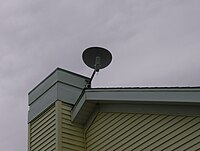Cambium Networks
Parts of this article (those related to Complete rebrand to cambium networks) need to be updated. (August 2014) |
| Type of signal: | LOS (line-of-sight), NLOS |
|---|---|
| Maximum range | 120 miles (190 km) PtMP, 155 miles (249 km) PtP[1] |
| Minimum range: | 500 metres (1,600 ft) (The Subscriber Modules (SMs) do not like having a "full blast" signal) |
| Maximum data throughput (Mbit/s) | 400 Mbit/s for PtMP (PMP 450)[2], 500 Mbit/s using PTP 820. |
Motorola Canopy is a fixed wireless networking system designed for wireless Internet service providers to provide Internet access. It uses relatively large antennas suitable for long range 900 MHz communication, typically over 1 metre (3 ft 3 in) long and 30 centimetres (12 in) or more wide, and these are subject to vibration in wind or due to motion, so this is not a true mobile technology.
Products are available in point-to-point and point-to-multipoint configurations. It includes both the original Motorola-designed products using the Canopy protocol and the PtP backhauls that were rebranded from Orthogon Systems which Motorola acquired in 2006.
Cambium Networks was created when Motorola Solutions sold the Canopy and Orthogon businesses in 2011. Cambium Networks has evolved the platform and expanded it to three product lines: Point to Point (PTP) (formerly Orthogon), Point to Multipoint (PMP) (formerly Canopy) and ePMP.
The technology competes with WiMAX, LTE and other long range mobile products, but not effectively with wired Internet, which is capable of much faster speeds and does not have wireless relay round trip delay. Competent Canopy implementations such as the Broadband for Rural Nova Scotia initiative however have demonstrated VoIP, gaming and other low latency applications work acceptably over this system, and in areas of challenging weather including high wind conditions (which cause antennas to move and affect connections).
Typical setup


A typical Canopy setup consists of a cluster of up to 6 co-located standard access points (AP), each with a 60 degree horizontal beamwidth antenna, to achieve 360 degree coverage. The most commonly used APs are available in 120, 180, or 360 degree models for site-based coverage, thus decreasing the number of APs needed on a tower. Also included would be one or more backhauls or otherwise out-of-band links (to carry data to/from other network occasions) and a Cluster Management Module (CMM) to provide power and synchronization to each Canopy AP or Backhaul Module (BM).
Customers of the system receive service through subscriber modules (SM) aimed towards the AP. The SMs should be mounted on the highest point of a building to get a reliable connection; otherwise, Fresnel zone obstruction will weaken the signal. Under ideal operating conditions, the system can communicate over distances of 3.5 to 15 miles (5.6 to 24.1 km) depending on the frequency using equipment with integrated antennas. Network operators can opt to install reflector dishes or Stinger antennas or to use Canopy models that accept external antennas at one or both ends of the link to increase coverage distance.
Most Canopy equipment receives its power using Power over Ethernet, however, none of its standards comply with IEEE 802.3af. A customer can query the status of their SM by viewing URL 169.254.1.1/main.cgi with a web browser (unless the network operator uses a different IP address or has put the subscriber in a VLAN.
In general, the 900 MHz version is more effective for use in outlying areas because of its ability to penetrate trees.[3] However, it requires careful installation because of the easy propagation of interference on that band. Other frequencies currently available are 2.4 GHz, 5.2 GHz, 5.4 GHz, and 5.7 GHz.
Comparison with other wireless networking systems
These products are fixed wireless technology. Canopy protocol products have many advantages over Wi-Fi and other wireless local area network protocols:
- Transmission timing is explicitly controlled, so that all access points (AP) on all towers can be synchronized by cluster management modules (CMM) to prevent interference. APs of the same band can be placed right next to each other, and back-to-back units can use exactly the same frequency.
- Designed for wireless internet service provider (WISP) use; polling-based (prevents one subscriber module from "hogging" bandwidth), excellent interference rejection and easy management.
- Simple to install and configure.
Their main disadvantages are:
- Proprietary
- Less reliable than wired systems
See also
References
- ^ "Solution Paper: Point-To-Point Solutions and WiMAX". Motorola. Archived from the original on 2007-07-11. Retrieved 2008-02-16.
{{cite journal}}: Cite journal requires|journal=(help); Unknown parameter|dead-url=ignored (|url-status=suggested) (help) - ^ http://www.cambiumnetworks.com/products/access/pmp-450m/
- ^ "Motorola Canopy Wireless Broadband - 900 MHz Modules". Motorola. Archived from the original on October 28, 2007. Retrieved 2008-02-16.
{{cite journal}}: Cite journal requires|journal=(help); Unknown parameter|deadurl=ignored (|url-status=suggested) (help)
